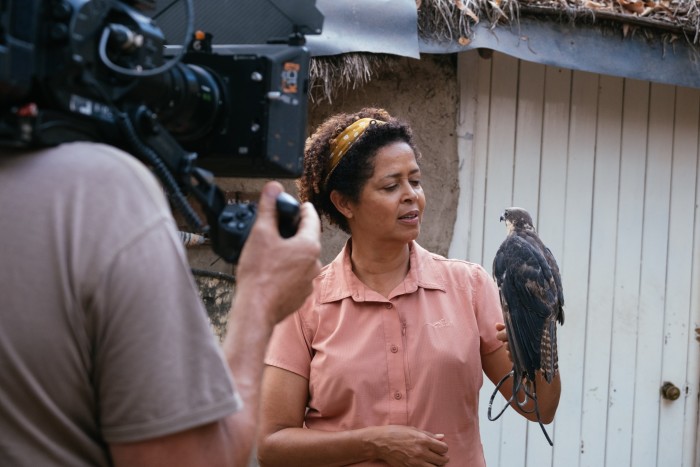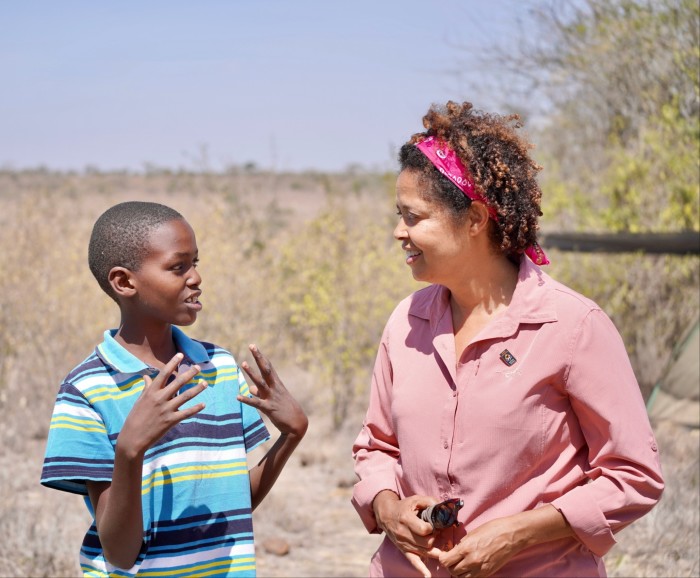Meet a champion of Kenyan wildlife protection

Simply sign up to the Life & Arts myFT Digest -- delivered directly to your inbox.
Spotting two black rhinos with the binoculars lent to him by Paula Kahumbu, a Kenyan conservationist-turned-television personality, 13-year-old Castro Masek is certain about his future. “I will become a conservationist, like daktari [doctor, in Kiswahili],” he says, referring to Kahumbu, who holds a doctorate from Princeton University.
Like most Kenyans, and despite living on the edges of Nairobi National Park, Masek had barely encountered wildlife before meeting Kahumbu, Africa’s answer to David Attenborough.
The 56-year-old presents and produces a show called Wildlife Warriors in which she travels to meet Kenyans working to save endangered animals. Now in its second season, it reaches an audience of more than 25mn people in Kenya alone.
Kahumbu, who has devoted her life to saving wildlife, is as convincing on-screen as she is explaining the properties of rhino dung to Kenyan schoolchildren on Saturdays at her “field lab” next to Kenya’s first national park in Nairobi, home to almost 100 black rhinos. “Why do we care about black rhinos? Because they are critically endangered,” Kahumbu tells Masek, who has come every Saturday for a year to learn from her about wildlife.

After decades of poaching — partly on the back of rising demand from Asia, where horn is used in traditional medicines — Kenya’s population of 20,000 black rhinos around the time of independence from Britain in 1963 has shrunk to only about 900, according to the latest figures of the Kenya Wildlife Service.
For the conservationist-turned-storyteller, the fact that many people are not familiar with her country’s wildlife is one of the biggest threats. “My job is to just bring sanity to the protection of our natural heritage,” Kahumbu says. “My purpose is not just to be a scientist, my purpose is really to do conservation through education, through innovation, through storytelling. As a conservation scientist, you’re only producing scientific articles that are only read by other scientists. But when you are on National Geographic or Disney that inspires people, educates them to care about nature,” Kahumbu says.
A protégée of the late conservationist and palaeoanthropologist Richard Leakey, Kahumbu is the chief executive of WildlifeDirect, an organisation protecting elephants. She has become the first African personality to bring wildlife to the masses in a country where most private conservation areas have traditionally been “dominated by white men in khaki shorts”, as one white conservationist puts it.
Even films and series about wildlife have been, mainly, presented by whites targeting white audiences. “There hasn’t been any wildlife content on Kenyan television for about 30 years. So we have one, maybe two generations of Kenyans who are not educated at all about nature. And that’s because films have been being made here, but they’re not being shown here,” Kahumbu says.
Four years ago she launched Wildlife Warriors with funding from the US Agency for International Development and the National Geographic Society; the show has been broadcasted in 26 countries. From April she will present the series Secrets Of The Elephants on the streaming service Disney+.
“I’m the first African to be presenting a story like this one globally,” says Kahumbu. “I’m the first, hopefully, not the last and there will be many more.” That is crucial to protect Kenya’s wildlife, she believes, something that since the 1973 hunting ban has been closely linked to tourists flocking to see the “Big Five” — lions, leopards, rhinos, elephants, and buffalo.
Tourism accounts for more than 10 per cent of Kenya’s gross domestic product, according to Kenya’s Tourism Research Institute, with wildlife being the top attraction. However, the Kenya Wildlife Service warns that key wildlife landscapes “have been experiencing challenges in terms of land tenure, land use system, increased livestock and poor husbandry practices, reduced rainfalls and increased droughts occasioned by global climate change among others”.
This is threatening “certain wildlife species populations” as well as exacerbating poaching for bushmeat and what conservationists call “human-animal conflict” over water, grasslands and farmlands. Last month, the Kenyan government announced it will pay 5.7bn Kenyan shillings ($45mn) to compensate victims of human-wildlife conflict.
“Quite a lot of the killing of wildlife is a statement — people won’t kill an elephant, they will make it suffer as a sign of frustration,” says Kahumbu.
For Kahumbu, the crux of the issue is clear: “We need stories to resonate locally. If we’re going to save Africa’s wildlife, we need local people to understand what the problems are to be part of the solution.”
Some 8 per cent of Kenya’s land mass is protected for conservation, including 23 national parks, 28 national reserves, and dozens of conservancies and private reserves, as well as marine areas. Some conservationists, including Kahumbu, argue that this is not enough to sustain the animals and more such areas are needed, simply because in the past three decades the country has lost about 70 per cent of its wildlife, according to the Kenya Wildlife Conservancies Association.
It’s an issue complicated by the debate around identity politics. “We have a narrative in Africa that is getting stronger and stronger by the day, which is that the conservation is a foreign thing, something from outside, that it’s not ours, that it’s not native to us, that our stories have got nothing to do with this — that is not true,” she says. “We need to protect more land, we need to secure all our protected areas better, we need to open up corridors between the national parks.”
That has earned her criticism. “Her television shows are about putting out her own views of what conservation should be,” says Mordecai Ogada, co-author of The Big Conservation Lie: The Untold Story of Wildlife Conservation in Kenya, who dislikes this idea of wildlife protection through tourism and conservation areas. “Her idea is very much the romanticised western safari idea of conservation.”
Kahumbu is now focusing on the younger generations with a show for African children presented by African children called Team Sayari, or “planet” in Kiswahili. In September last year, WildlifeDirect, the Walt Disney Company Africa, National Geographic, and the US government launched the programme.
It broadcasts on DStv from Kenya to all over Africa and links to child presenters in Nigeria, Rwanda, Tanzania and South Africa aimed at nurturing the next generation of environmentalists and conservationists.
For Kahumbu, who created the stories, “the power of the series lies in the voices of African children calling each other to action.”
Juliet Waiyaki heard that call a few years ago after watching Kahumbu on television. “It was like a revelation,” she says. The 25-year-old is now a wildlife veterinarian working at a rehabilitation centre for raptors injured by power lines in the Soysambu Conservancy in south-west Kenya. “To me she is even more educational than Attenborough because I can relate to her,” says Waiyaki. “She commands so much authority — she is truly inspiring.”
Find out about our latest stories first — follow @ftweekend on Twitter
Comments